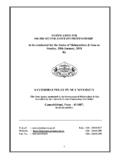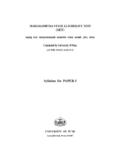Transcription of Maharashtra State Eligibility Test for Lectureship
1 Maharashtra State Eligibility Test for Lectureship _hmam > am ` `m `mVm[XmgmR>r am ` Var` [m Vm MmMUr (g{Q>) [arjmConducted by University of Pune(AS THE State AGENCY)SYLLABUS AND SAMPLE QUESTIONS Subject Subject Code SciencesUNIVERSITY OF PUNEG aneshkhind, Pune-411007 SET (Life Sciences) / 2life science_SET syllabus (03-09)[34] : LIFE SCIENCESThe syllabus consist of two papers as follows :Paper II and Paper III will be of 75 minutes and 2 hours duration respectively. Paper II willbe of 100 marks and Paper III will be of 200 marks. In Paper III there will be 10 questions eachof Botany, Zoology, Microbiology, Biochemistry and remaining 20 questions are of Genetics, have to attempt any 20 Biology : Structure and function of cells and intracellular organelles (of both prokaryotesand eukaryotes), Mechanism of cell division including (mitosis and meiosis) and celldifferentiation.]]]}
2 Cell-cell interation, Malignant growth, lmmune response : Dosage compensationand mechanism of sex : Structure of atoms, molecules and chemical bonds, Principles of physicalchemistry, Thermodynamics, kinetics, dissociation and association constants, Nucleic acidstructure, genetic code, replication, transcription and translation : Structure, function andmetabolism of carbohydrates, lipids and proteins, Enzymes and coenzyme, Respiration : Response to stress, Active transport across membranes, Plant and animal hormonesNutrition (including vitamins), Reproduction in plants, microbes, plant and animals, Sensoryresponses in microbes, plant and : Principles of Mendelian inheritance, chromosome structure and function, GeneStructure and regulation of gene expression, Linkage and genetic mapping, Extra-chromosomalinheritance (episomes, mitochondria and chloroplasts), Mutation, DNA damage and repair,chromosome aberrations, Transposons, Sex-linked inheritance and genetic disorders, Somaticcell genetics, Genome organisation (in both prokaryotes and eukaryotes).
3 Biology : Origin of life (including aspects of prebiotic environment and molecularevolution), Concepts of evolution, Theories of organic evolution, Mechanisms of speciation,Hardy-Weinberg genetic equilibrium, genetic polymarphism and selection, Origin and evolutionof economically important microbes, plants and biology : Concept and dynamics of ecosystem, components, food chain andenergy flow, productivity and biogeochemical cycles, Types of ecosystems, Population ecologyand biological control, Community structure and organisation, Environmental pollution,Sustainable development, Economic importance of microbes, plants and and Taxonomy : Species concept, Biological nomenclature theories of bilogicalclassification, Structural biochemical and molecular systmatics, DNA finger printing, numericaltaxonomy, Biodiveristy, characterization, generation, maintenance and loss, Magnitude anddistribution of biodiversity, economic value, wildlife biology, conservation strategies, (Life Sciences) / 3life science_SET syllabus (03-09)PAPER III1.
4 Principles of Taxonomy as applied to the systamics and Classification of Plant Kingdom,Taxonomic structure, Biosystematics, Plant geography, Patterns of variation in morphology and life history in plants, broad outlines of classificationan evolutionary trends among algae, fungi, bryophytes and pteriophytes, Principles ofpalaeobotany, Economic importance of algae, fungi and Comparative anatomy and developmental morphology of gymnosperms and angiosperms,Histochemical and ultrastructural aspects of development, Differentiation and Androgenesis and gynogenesis, Breeding systems, Pollination biology, structural and functionalaspects of pollen and pistill, Male sterility, Self and inter-specific incompatibility, Fertilization,Embryo and seed and civilization : Centres of origin and gene diversity, Botany, utilization, cultivationand improvement of plants of food, drug, fibre and industrial values, Unexploited plants ofpotential economic value, Plants as a source of renewable energy, Genetic resources and Relations : Mineral nutrition, Photosynthesis and photorespiration : Nitrogen,Phosphorous and Sulphur metabolism, Stomatal physiology, Source and sink Physiology and biochemistry of seed dormancy and germination, Hormonal regulation ofgrowth and development, Photoregulation.
5 Growth responses, Physiology of flowering, of plant breeding : Important conventional methods of breeding self and crosspollinated and vegetatively propagated crops, Non-conventional methods, Polyploidy : Geneticvariability, Plant diseases and defensive Principles of taxonomy as applied to the systematics and classification of the animal kingdom,Classification and interrelationship amongst the major invertebrete phyla, Minor invertebratephyla, functional anatomy of the non-chordates, Larval forms and their evolutionary Classification and comparative anatomy of protochordates and chordates, Origin, evolutionand distribution of chordate groups : Adaptive Histology of mammalian organ systems, nutrition, digestion and absorption, Circulation (openand closed circular, lymphatic systems, blood composition and function), Muscular contrationand electric organs, Excretion and osmoregulation : Nerve conduction and neurotransmitter,major sense organs and receptors, Homeostatis (neural and hormonal), Bioluminiscence, (Life Sciences) / 4life science_SET syllabus (03-09) in animals : Molecular events during fertilization, Cleavage patterns and fatemaps, Concepts of determination, competence and induction, totipotency and nuclear transferexperiments, Cell differentiation and differential gene activity.
6 Morphogenetic determinants inegg cytoplasm, Role of maternal contributions in early embryonic development, Geneticregulation of early embryonic development in Drosophila, Homeotic Feeding, learning, social and sexual behaviour of animals, Parental care, Circadian rhythms,Mimicry, Migration of fishes and birds, Sociobiology, Physiological adaptation at high Important human and veterinary parasites (protozoans and helminths), Life cycle and biologyof Plasmodium, Trypanosoma, Ascaris, Wuchereria, Fasciola, Schistosoma and Leishmania,Molecular, cellular and physiological basis of host-parasite Arthropods and vectors of human diseases (mosquitoes, lice, flies, and ticks), Mode oftransmission of pathogens by vectors, Chemical biological and environmental control ofanthropod vectors, Biology and control of chief insect pests of agricultural importance, Planthost-insect interaction, insect-pest management, useful insects, The law of DNA constancy and C-value paradox, Numerical and structural changes inchromosomes, Molecular basis of spontaneous and induced mutation and their role in evolution,Environment mutagenesis and toxictiy testing, Population Structure of pro and eukaryotic cells, Membrane structure and function, Intracellularcompartments, protein sorting, secretory and endocytic pathways, Cytoskeleton, Nucleus.
7 Mitochondria and chloroplasts and their genetic organisation, cell cycle, Structure andorganisation of chromatin, polytene and lamphrush chromosomes, Dosage compensation andsex determination and sex-linked Interactions between environment and biota, Concept of habitat and ecological niches, Limitingfactors, Energy flow, food chain, food web and trophic levels, Ecological pyramids and recycling,Biotic community concept, structure, dominance, fluctuation and succession, and SCycles in Ecosystem dynamics and management : Stability and complexity of ecosystems, Speciationand extinction, Environmental impact assessment, Principles of conservation, Conservationstrategies, Sustainable Physico-chemical properties of water, Kinds of aquatic habitats (fresh water and marine),Distribution of and impact of environmental factors on the aquatic biota, Productivity, mineralcycles and biodegradation in different aquatic ecosystems, Fish and Fisheries of India withrespect to the management of estuarine, coastal water systems and man-made reservoirs,Biology and ecology of Structure, classification, genetics, reproduction and physiology of bacteria and viruses (ofbacteria, plants and animals)
8 , Mycoplasma protozoa and yeast (a general accounts).SET (Life Sciences) / 5life science_SET syllabus (03-09)22. Microbial fermentation, Antibotics, organic acids and vitamins, Microbes in decompositionand recycling processes, Symbiotic and asymbiotic N2 - fixation, Microbiology of water, air,soil and sewage, Microbes as pathological agents in plants, animals and man, General designand applications of a biofermenter, : Structure and functions of different clauses of immunoglobulins, Primary andsecondary immune response, Lymphocytes and accessory cells, Humoral and cell mediatedimmunity, MHC, Mechanism of immune response and generation of immunotogical diversity;Genetic control of immune response, Effector mechanism, Application of Enzyme kinetics (negative and positive cooperativity), Regulation of enzymatic activity, Activesites, Coenzymes, Activators and inhibitors, isoenzymes, allosteric enzymes, Ribozyme Van der Waal s electrostatic, hydrogen bonding and hydrophobic interactions, Primary structureof proteins and nucleic acids, Conformation of proteins and polypeptides (secondary, tertiary,quanternary and domain structure)
9 , Reverse turns and Ramachandran plot, Structuralpolymorphism of DNA, RNA and three-dimensional structure of tRNA, Structure carbohydrates,polysaccharides, glycoproteins and peptido-glycans, Helix-coil transition, Energy terms inbiopolymer conformational Glycolysis and TCA cycle, Glycogen breakdown and synthesis, Gluconeogenesis, interconversionof hexoses and pentoses, Amino acid metabolism, Coordinated control of metabolism,Biosynthesis of purines and pyrimidines, Oxidation of lipids, Biosynthesis of fatty acids,Triglycerides, Phospholipids, Energy metabolism (concept of free energy), Thermodynamic principles in biology, Energyrich bonds, Weak interactions, Coupled reactions and oxidative phosphorylations, Group tranfers,Biological energy tranducers, Fine structure of gene, Eukaryotic genome organisation (structure of chromatin, coding andnon-coding sequences, satellite DNA), DNA damage and repair, DNA replication, amplificationand Organization of transcriptional units : Mechanism of transcription of prokaryotes and eukaryotes,RNA processing (capping, polyadenylation, splicing, int)









